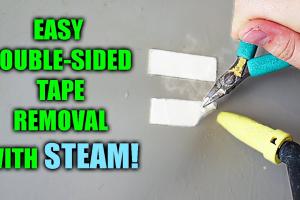Ultimate Guide to Effectively Remove Double Sided Tape Without Damage

-
Quick Links:
- Introduction
- Understanding Double Sided Tape
- Common Uses of Double Sided Tape
- Why You Might Need to Remove Double Sided Tape
- Tools You’ll Need
- Step-by-Step Removal Guide
- Case Studies
- Expert Insights
- Common Mistakes to Avoid
- Best Practices for Prevention
- FAQs
Introduction
Double sided tape is a versatile adhesive that can be found in many households and workplaces. It is favored for its ease of use and strong bonding capabilities. However, when it’s time to remove it, you may face challenges that could potentially damage the underlying surface. This guide will delve into effective techniques for safely removing double sided tape and the necessary tools to ensure a smooth process.
Understanding Double Sided Tape
Double sided tape consists of an adhesive layer on both sides of a thin, flexible film. This design allows it to bond two surfaces together without being visible. The tape is available in various strengths and materials, making it suitable for a range of applications, from craft projects to securing carpets.
Common Uses of Double Sided Tape
- Arts and crafts
- Home decor
- Repairing carpets
- Mounting pictures and frames
- Automotive applications
Why You Might Need to Remove Double Sided Tape
Removing double sided tape can be necessary for various reasons, including:
- Replacing or repositioning items
- Cleaning surfaces
- Preventing damage when moving or renovating
Tools You’ll Need
To effectively remove double sided tape, gather the following tools:
- Plastic scraper or putty knife
- Heat gun or hair dryer
- Adhesive remover
- Cotton balls or soft cloths
- Rubbing alcohol or vinegar
Step-by-Step Removal Guide
Follow these detailed steps to remove double sided tape without damaging surfaces:
Step 1: Prepare the Area
Clear the area around the tape to ensure you have enough space to work. Protect the surrounding surfaces with drop cloths or newspaper.
Step 2: Apply Heat
Using a heat gun or hair dryer, gently warm the tape for about 30 seconds. This will soften the adhesive, making it easier to remove.
Step 3: Use a Scraper
Once the tape is warm, use a plastic scraper to gently pry the tape away from the surface. Start at one corner and work your way across.
Step 4: Clean Residue
If adhesive residue remains, apply a small amount of adhesive remover or rubbing alcohol on a cotton ball and gently rub the area until the residue is gone.
Step 5: Final Clean
Wipe the area with a clean cloth to remove any leftover chemicals and ensure the surface is restored.
Case Studies
Case Study 1: Removing Tape from Painted Walls
A homeowner needed to remove double sided tape used for hanging pictures. By following the heat and scrape method, they successfully removed the tape without damaging the paint.
Case Study 2: Removing Tape from Wood Furniture
A furniture maker had to remove tape that secured parts during assembly. Using a combination of heat and adhesive remover, they preserved the wood finish while eliminating residue.
Expert Insights
We consulted experts in home improvement and adhesive technologies. They recommend always testing a small inconspicuous area first to gauge how the surface reacts to heat and adhesive removers.
Common Mistakes to Avoid
- Using metal tools that can scratch surfaces.
- Applying too much heat, which can damage some surfaces.
- Forgetting to test adhesives on a small area first.
Best Practices for Prevention
To avoid issues with double sided tape in the future, consider the following tips:
- Choose the right type of tape for the job.
- Limit exposure to extreme temperatures.
- Regularly check items secured with tape to ensure they remain intact.
FAQs
1. Can I use a knife to remove double sided tape?
It is not recommended to use a knife, as it may scratch or damage the surface.
2. What is the best adhesive remover?
Many experts recommend using rubbing alcohol or commercial adhesive removers like Goo Gone.
3. Does heat damage all surfaces?
Not all surfaces react the same way to heat; always test a small area first.
4. How can I remove tape from wallpaper?
Use a gentle adhesive remover and avoid using excessive heat to prevent damaging the wallpaper.
5. Can I reuse double sided tape?
Once removed, double sided tape generally loses its adhesive properties and cannot be reused effectively.
6. Will vinegar help remove double sided tape?
Yes, vinegar can help dissolve the adhesive, but it may require some scrubbing.
7. Is it safe to use heat on plastic surfaces?
Exercise caution, as some plastics can warp or melt. Always test first.
8. How do I remove tape from glass?
Use a razor blade at a low angle to gently scrape off the tape, combined with a glass cleaner for residue.
9. What if the tape is stuck on fabric?
Gently pull at the fabric while using a fabric-safe adhesive remover. Avoid pulling too hard to prevent tearing.
10. What should I do if the surface gets damaged during removal?
Assess the damage and consider repairing or refinishing the area based on the severity of the damage.
Random Reads